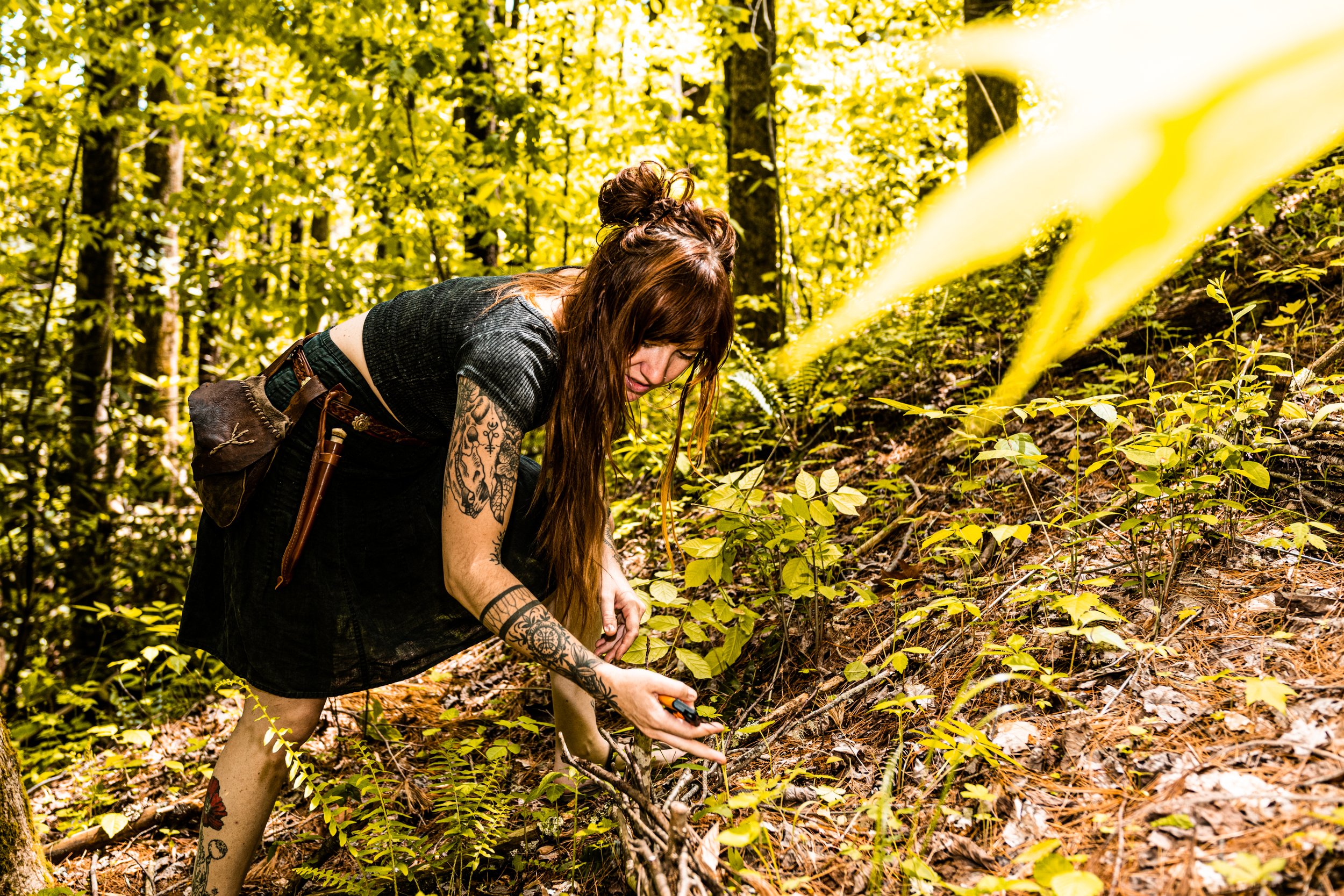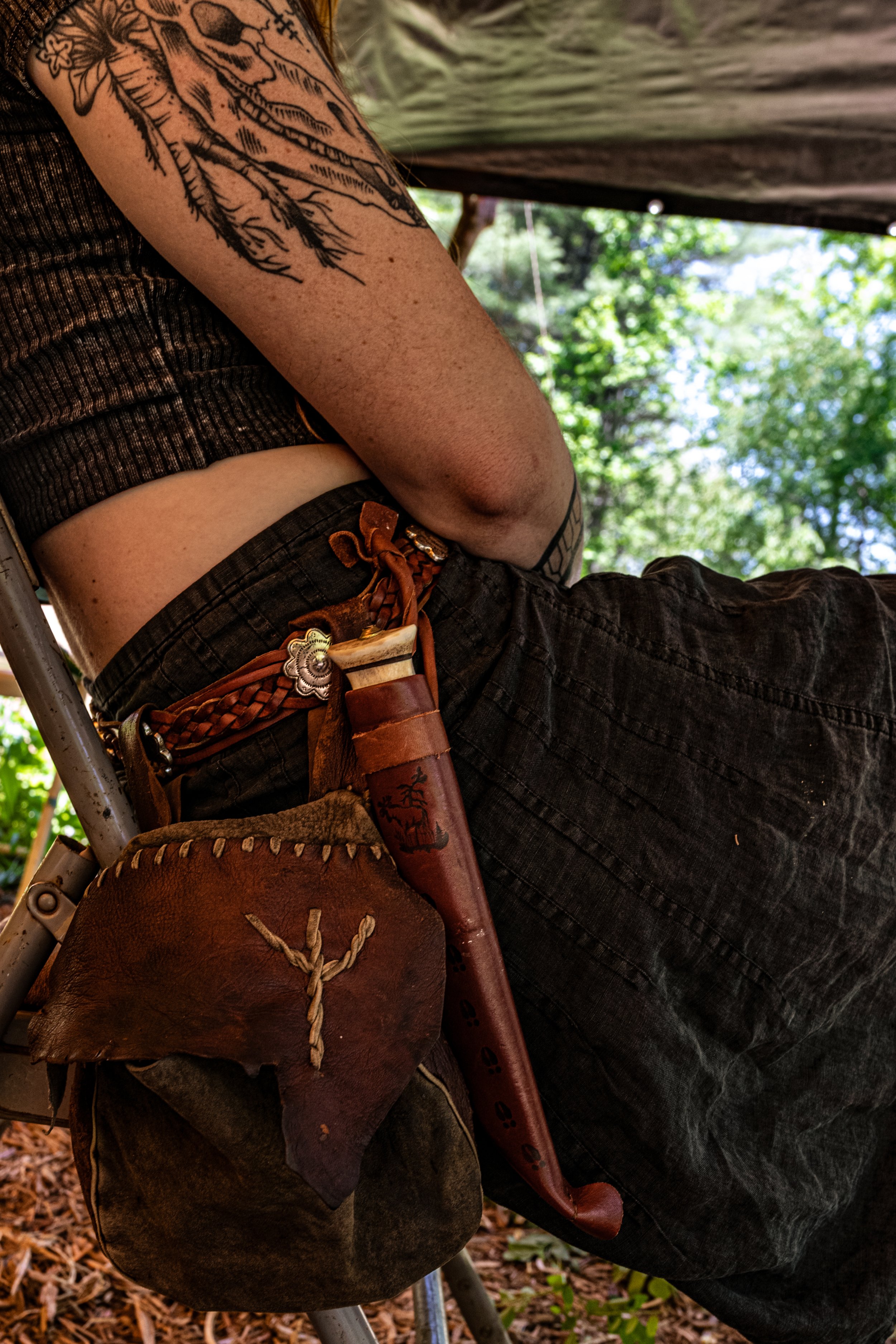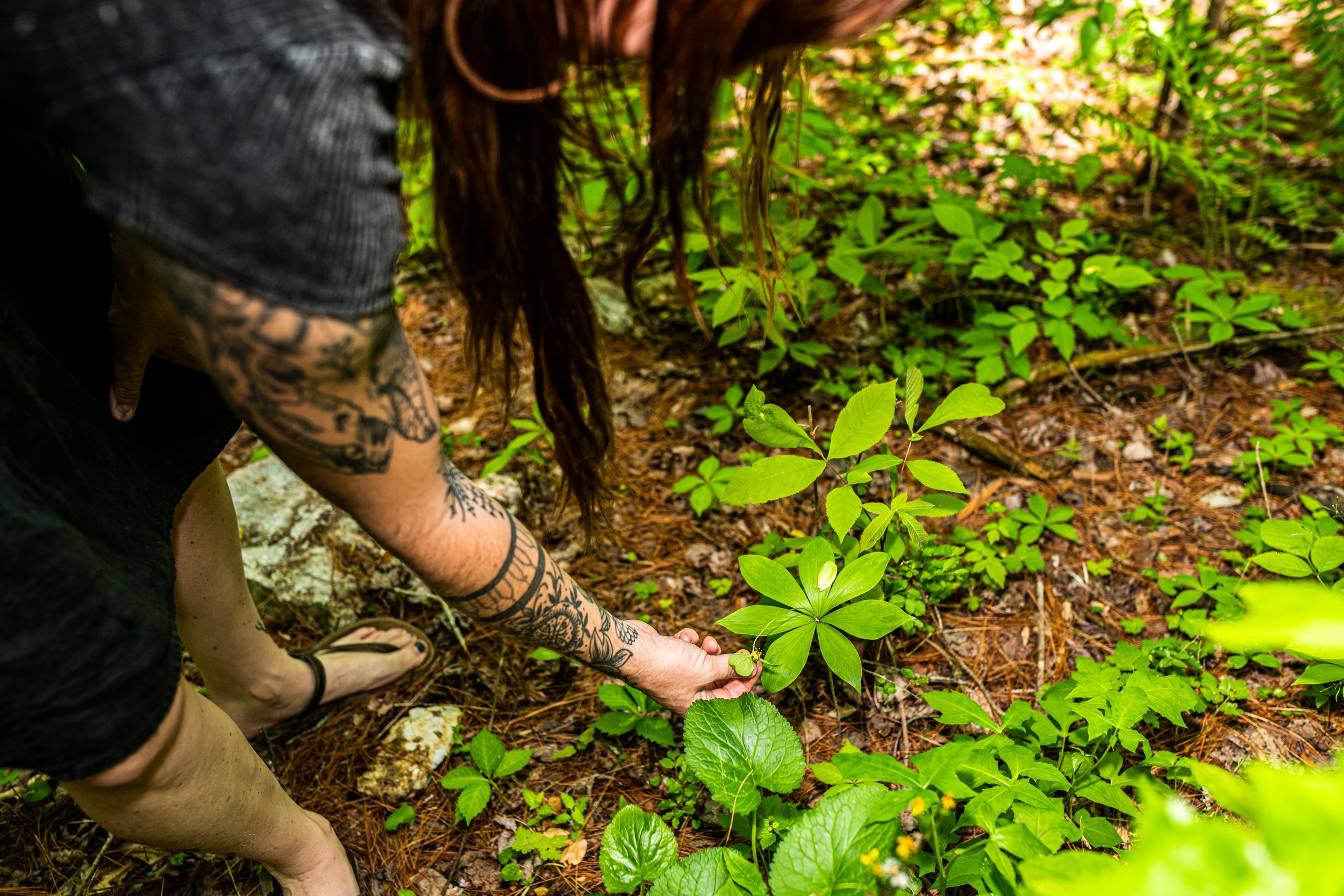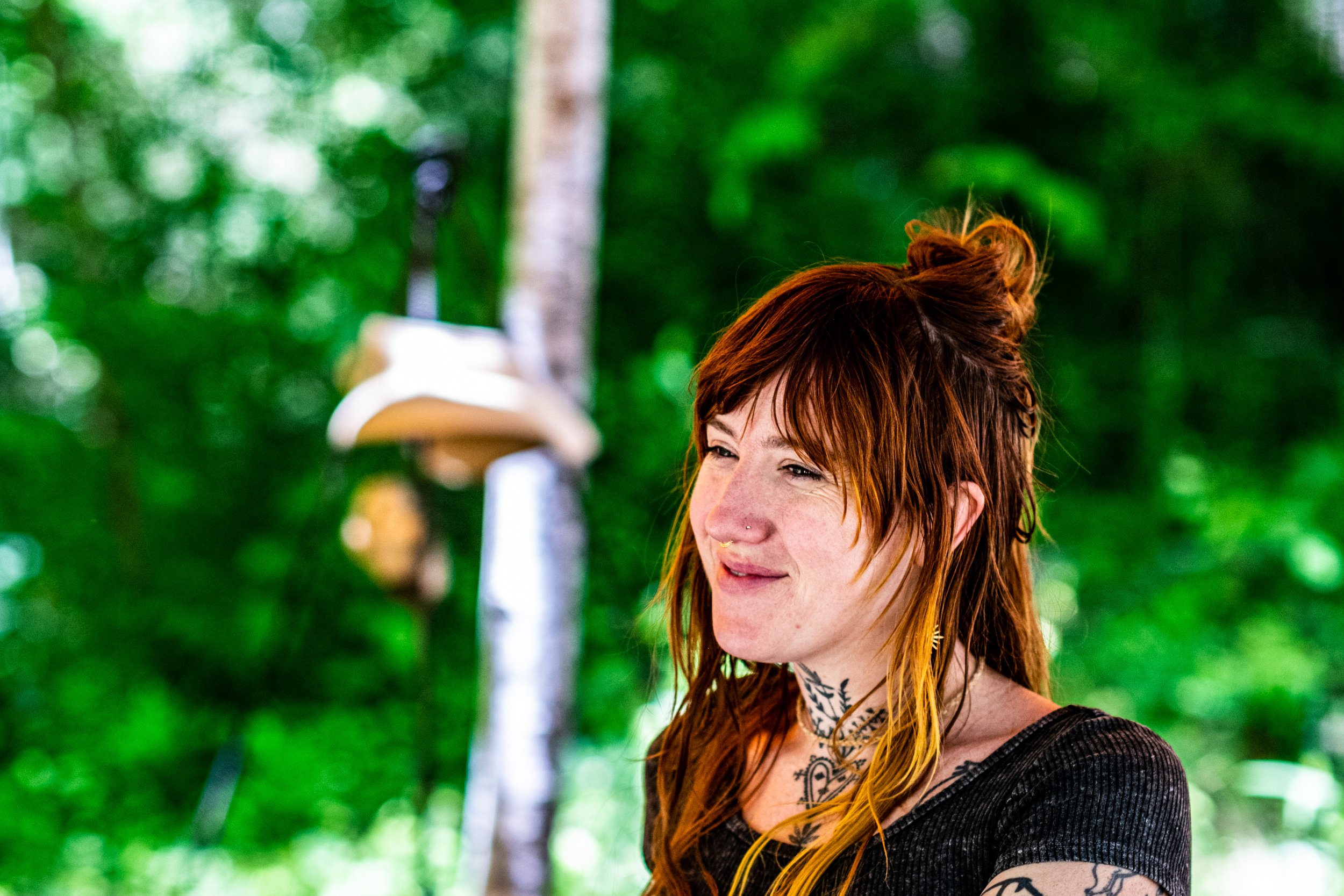Rebecca Beyer makes her home in, and runs her business from, a sun-bleached bus parked on her nine-acre tract in the mountains of North Carolina. As a forager, earthcrafter, herbalist, tattoo artist, folklorist, ethnobotanist, musician, huntress, and witch, she wants to remind folks that any separation they feel from nature is a delusion.
Words by Kimberly Coburn | Photos by Nathan Lopez
The Blood and Spicebush School of Old Craft sits nestled in the palm of the Blue Ridge range of the southern Appalachians. There, the mountains seem immovable. Their topography, with the regrettable exception of a few summits lost to our hubris and hunger for coal, has looked the same to all human inhabitants of the mountain South. They’re old. Real old.
When you hike the scenic trails threaded through western North Carolina’s lush rainforests, the stone sleeping under the dark soil once belonged to a billion-year-old supercontinent: Pangaea’s great-grandparent. This rock was here before mastodons and dinosaurs, before dragonflies the size of peregrine falcons filled the air with the bagpipe drone of their wings, before the green engine of plant life itself. Once as tall as the Himalayas and now only 6,684 feet at the tip-top of Mount Mitchell, these weathered peaks, cozied in their verdant quilts of spring growth, flout our perception of time and betray our mayfly minds.
But the mountains are nomads. Plates collide, buckle skyward, and weather back to earth. They break apart, drifting and dashing against one another in endless orogenies. Just outside Marshall, North Carolina, about 25 minutes north and west of Asheville, a few thousand millennia of this ceaseless migration have tucked rich soil in sheltered coves and carved valleys that cradle clouds, inviting rain; they have offered sanctuary from the inexorable southern march of glaciers during the last ice age. They have rendered the region one of the most biodiverse in the temperate world: a cornucopia of plants, fungi, trees, insects, and congress upon congress of salamanders.
And it’s here, on a nine-acre tangle of feral, companionable woodland, that Rebecca Beyer is finally making her home.
Rebecca Beyer wild-tends the land, a practice that encourages the spread of existing stands of native plants by removing competitors.
It would be easy to miss the gravel driveway jutting out from a wall of trees and vines were it not for a slim wooden sign with the single hand-painted word “Lindera”: the genus name of the native spicebush plant that festoons these woods with glossy red berries each fall. A replacement for allspice and a breaker of fevers, this unassuming shrub has wrapped its roots around Rebecca’s heart. It inspired the name of not only her property but also her blog and the school she runs from her forest campus of hand-built structures, where she teaches people foraging, herbalism, folklore, and other ways to live close to the land.
Rebecca steps down the stairs of a sap-splotched Blue Bird school bus. A stovepipe rises out of its roof like a periscope surveying the surrounding woods. Half of her long red hair is piled into a loose topknot. A pale canvas of intricate tattoos peeks out from beneath the sleeves of her cropped shirt and the hem of her knee-length black skirt. She would look entirely at home on any city street except for the braided leather belt slung around her waist, an antler-handled knife in its hand-stitched sheath, and a two-toned buckskin bag hanging low on her hip. A symbol the shape of a chicken’s foot in twisted leather cording adorns the bag’s flap. “A courting gift,” she tells me, running her finger along the leather with a private smile. “It’s the rune for protection.”
All around the bus are signs of a place in flux, a home in potentia, with woodpiles and wheelbarrows propped against the waist-high bus wheels. “Home is such a funny thing for me,” she says, looking into the middle distance as if she might see her childhood self standing there. “It always felt like an artifice or something. I never felt at home in any of the places my family lived, and we moved constantly. I think my parents were deeply unhappy, and they kept moving to try to find happiness.”
Beyer and her partner decided to park their converted bus on her nine-acre tract just outside Marshall, North Carolina.
Growing up all over rural New Jersey, Rebecca completed her soil sciences degree at the University of Vermont before following a friend to western North Carolina. She settled in, bought a piece of land to share, and got a master’s in Appalachian Studies at Appalachian State University, with a self-directed focus in ethnobotany. Despite her fierce, newfound love for the region, it wasn’t all smooth sailing. She candidly tells me that in the decade she has owned the land, it has witnessed failed attempts at communal living, a divorce, and wrangles with addiction. She even tried to sell it for a time. But a little over a year ago, she and her partner decided to park a converted bus against the tree line with big plans, a solid grasp of carpentry, and a pile of reclaimed lumber. “Now that I live in Appalachia, I will always live here,” she says. “I’ve really sunk down into that bioregional identification of where I live and what is for me here.”
We duck beneath a timber-supported tarp tent and sit in a cluster of folding chairs left over from a Women’s Rewilding Weekend she hosted. A paper grocery bag and a wide stainless steel bowl rest on the ground between us. Something smells like snapped pea tendrils and vanilla. She opens the bag and fluffs up handfuls of delicate white flowers, sending a plume of heady spring perfume into the humid air. She tells me they are black locust flowers, a delicacy that blooms briefly and makes an amazing mead. I push aside any hesitation and pop one in my mouth. The taste is a sweet, vegetal jasmine, the first of many new flavors I’d experience that day. Her hands deftly separate the blossoms from their slightly toxic leaves and stems, heaping a pillowy cloud of petals in the silver bowl.
Beyer wears a braided leather belt, an antler-handled knife in a hand-stitched sheath, and a buckskin bag. The latter, adorned with a rune for protection, was given to her as a courting gift.
Signs of Rebecca’s varied talents are scattered throughout the tent: curls of greenwood left over from carving spoons, a hand-forged tripod for campfire cooking, an altar with incense and bundles of dried herbs beside a bear skull. Like many of the plants she studies that offer both food and fuel, medicine and fiber, she’s a generalist. In our hyperspecialized world, you might wonder how she fits all her pursuits — teacher, herbalist, earthcrafter, tattoo artist, folklorist, ethnobotanist, musician, huntress, witch — into one lifetime, let alone a typical day. She shrugs it off, as if having that many skills were the most natural thing in the world.
“I’m a forager. That’s what I am first and foremost.” She finishes separating the flowers and sets the bowl on a chair. “I love helping people find food.” For Rebecca, teaching foraging is a way to preserve increasingly endangered knowledge. She explains how much biodiversity we’ve lost in our diets. As she tells it, the people indigenous to this area — mostly the Cherokee, but also the Miccosukee and Yuchi — ate between 1,200 and 1,700 species of plant, animal, and fungus. Now the average American eats 32 plant varieties in their lifetime. With somewhere between 400 and 500 wild edibles in western North Carolina, Rebecca introduces people to 12 to 15 of them on her walks.
This gentle foray into foraging is more than botanical identification and recipe ideas. It’s a reclamation of something easily buried under asphalt: our own inherent intimacy with the natural world. Rather than striving to “reconnect” her students with nature, she endeavors to remind us that any separation we might feel is actually a delusion: “The biggest lie we’ve ever been told is that you have to ‘go back’ to nature, as if you were ever gone from it.”
I follow her up a tree-shrouded hillside, marveling at her feet’s preternatural ability to navigate around the minefields of poison ivy. Walking animates her tattoos. Red poppies nod on one calf, a blacksnake coils lazily on the other. A resurrection fern unfurls on her arm alongside a long stem of pokeweed. Plants and animals are common motifs in her designs. Though she has been a professional tattoo artist for only three years, Rebecca has witnessed the way tattoos offer people a chance to reinhabit their own body, to be more comfortable in their newly inked skin. “A lot of times I tattoo over self-harm scars,” she says. “I always tell people, ‘If you don’t like a part of your body, just tattoo it and you’ll love it.’”
We arrive in a small clearing where a spring bubbles from a stone-lined recess in the earth. All around it grows a garden unlike any I have ever seen. This is a woodland garden: a far cry from the manicured and polite azaleas and privet of my neighborhood in Atlanta. Untrained eyes wouldn’t even have been able to distinguish it from the rest of the undergrowth if it weren’t for the woven-branch wattle edges defining the terraced beds. Here, Rebecca gently encourages the spread of existing stands of native plants, removing competitors for the dappled understory light. She calls the practice wild-tending: protecting the plants, ensuring their continued survival, and using them for food and medicine.
“I’m a forager. That’s what I am first and foremost,” Beyer says.
The long tongues of ramps, or wild leeks, loll over the edges of the beds, their glossy green streaked ruddy at the stems. Ethical harvesting of ramps requires a bit of self-restraint, taking only a judicious amount of the garlicky leaves and leaving the rooted bulbs in place. Though populations of the plant have been strained by their sudden popularity with chefs and gourmets, these pungent, onion-family delicacies have long been revered in Appalachia. One of the first edibles of spring, their emergence from the soil was a celebration of surviving another winter, and eating them was considered a tonic for sluggish blood. But because of their slow growth — a stand can take up to seven years to become established — ramps run the risk of being overharvested.
To ensure the ramps aren’t crowded out, Rebecca tugs the slender root of a frilly-leafed plant from the earth, scratches it with her nail, and smells it. She breaks off a leaf and begins to nibble on the stem, handing another to me. It tastes like a confusing and alluring cross between celery and licorice. “Aniseroot,” Rebecca tells me. “See the long seeds? We dry them and grind them as a spice for that anise flavor.” We walk no more than three more steps before she plucks a maple-shaped leaf from a bushy clump at our feet and hands it to me. Its vivid green surface looks stained with pale watermarks. “That’s why it’s called waterleaf,” she says smiling, nibbling again. I follow suit and am surprised by its sweetness, like sugar-frosted spinach.
Beyer observes Medeola virginiana, often called Indian Cucumber, in flower.
Now I’m hooked on forest snacks. She points out the bright parasol whorl of the so-called Indian cucumber and tears a piece from the leaf. It tastes and smells exactly like cucumber skin. Beside it grows the distinctive lady’s thumbprint, with a pink smear of color in the middle of each of its lance-shaped leaves. A member of the buckwheat family, its texture is woolly and its flavor unremarkable, with notes of clean sock. Rebecca snaps off the yellow-green new growth tips of a hemlock tree: a powerful punch of citrus and resin. She picks a violet and shows it to me. “I bet you know this one. But did you know,” she asks, picking the petals apart to show me their tufted insides, “that they have secret beards?” She chuckles. “I love to tell my students that.”
It’s astonishing. In just a couple of square feet, Rebecca shows me no fewer than 10 plants I could turn to for food or medicine. She smiles, unsurprised at my bewilderment. “When you see someone who’s never been in a wild space experience picking and eating food for the first time, there’s a light that fills their eyes.” It’s a transformation she recognizes because she has experienced it herself; learning that the plants all around you are sources of nourishment can ease the sense of alienation many of us carry around with us: “You feel held. If you wake up and you feel like trash, like no one loves you, just go outside. There are eight plants that will heal you or feed you, and they won’t charge you a dime. I think, to a lot of people, that feels like coming home.”
We walk back down the hill, passing oxeye daisies (“good for pickling”) and lyreleaf sage (“good for sore throats”). I wonder what it would be like to be so fluent in the language of plants, to be able to read the unfurling stories in their leaves. Some of them, Rebecca points out, recount a history lesson: the healing remedies people brought with them to unknown lands for uncertain futures, evidence of a colonial past written in nettle, dandelion, and chickweed. Her favorite tales the plants tell, though, are the ones about magic. “When you study the folk magic of an area,” she tells me, “you can understand the surface of it with plants. That’s the skin of the land. But then you go on to understand the weird current that’s running under all of it when you look at the magical practices of the land.”
In her new book, Wild Witchcraft, Rebecca weaves together the threads of foraging, herbalism, and folk magic into various spells, rituals, and remedies. For most of history, little distinction was made between the magical and the medicinal, but times have changed. Like foraging, magic slows us back to the pace of the seasons and anchors our busy minds to the phases of the moon. The lore of a place offers a route to more meaningfully and intimately understand land to which we are not indigenous: “There is no better way to honor the places that we live, and the beings that dwell there, than to remember and discover the ways that went before.” Rebecca considers herself Irish and German ancestored, but is careful not to presume an understanding of those cultures. She views folk magic — like foraging — as an entry point for those of us estranged from, or reconciling with, our heritage to find a meaningful connection with place. “And,” she adds, “we can do it without spiritual picking-and-choosing in appropriative ways that cause harm to indigenous folks and people of color.”
This is crucial in a place as culturally diverse and historically fraught as Appalachia. When teaching, Rebecca introduces the folklore of Appalachia as a stool with a European leg, an African American leg, and a Native American leg. All of Appalachian culture, including its multistrand magic, sits supported by these three legs.
Among other items pointing to Beyer’s varied talents: a bear skull with incense and bundles of dried herbs atop an altar.
For over 250 years, the human inheritance of this place has been one marked by leaving: immigration, enslavement, and the forced removal of people and mountaintops. Maybe because of this specter of loss, home is paramount in the Appalachian consciousness and, by extension, its folk magic. “There are hundreds of spells to protect the home,” Rebecca says. “The horseshoe above the door. Putting shears above the door to cut the evil as it walks through. Leaving jars of rice in front of your door, which comes from Gullah people in South Carolina. I think if anyone's trying to protect something, it's a signifier of value.” She pauses to think. “Other than arthritis protection, it might be the most commonly sought magical purpose.”
But for every enchantment safeguarding a place, there’s a lament for having to leave it. And in Appalachia, sorrow finds its voice in a different kind of spell casting. “There are so many Appalachian ballads about traveling,” Rebecca explains. “‘Wayfaring Stranger,’ ‘Lonesome Pilgrim.’” The list is long. “Like that song ‘Long Time Travelin’ — do you know that one?” I shake my head. Rebecca closes her eyes, tilts her head, and begins to sing in a drowsy, honeyed alto: “I’m a long time travelin’ here below / I’m a long time travelin’ away from home.”
In most of these songs, the traveler is a soul bound for heaven, slogging through the trials and tribulations of a hard world. “There are a lot of songs like that,” Rebecca says, “where they're singing about being homeless. It’s from a really complex and painful history. But also, here are these mournful songs we can all connect with because everybody feels out of place or othered at some point in their life. I feel like Appalachia is continuously othered in American culture. You can sense that in the music of the land, for sure.”
I’m not sure what songs mountains sing; I’m too small for that. Maybe in their forever-drifting way, they long for home, too. We sit quietly for a moment, and I can almost convince myself I hear the wind whisper an agreement through the leaves until a wet plop from the nearby pond punctuates the stillness.
Rebecca laughs. “Did you hear that frog?”
As a professional tattoo artist, Beyer has witnessed the way tattoos offer people a chance to reinhabit their own body. She says, “I always tell people, ‘If you don’t like a part of your body, just tattoo it and you’ll love it.’”
Leaving Lindera, I roll down my windows and drive the serpentine mountain roads to where they cross the French Broad. I park by the wide, murky river — the third-oldest in the world, flowing without rest for 250 million years — and catch a familiar scent. A tall black locust tree dangles clusters of white flowers along the river’s bank. I get out of the car and go over to it. Often disparaged as a weed tree, black locust is North America’s strongest, most rot-resistant wood; the fence posts it makes can last a century. Sill plates — the first piece of wood on a house that anchors it to the foundation — made from its lumber are among the sturdiest. And as a member of the pea family, it fixes nitrogen, nourishing and restoring tired soil. It’s a homesteader’s dream.
I slide my closed fingertips down a flower stem and catch the birdlike blossoms in my palm. I taste them, watching the slow ribbon of river, and think about Rebecca. Something in her core, too, understands the making of a home. Like so many of us, she does not feel rooted by her place of birth or in her ancestry. She didn’t inherit a lineage of knowledge, but instead sought out teachers to show her which plants feed, heal, and harm; to show her how to listen to the land. Now, she passes that knowledge on to others.
Rebecca Beyer knows a secret, one understood by the elderly river and the itinerant mountains. It’s a secret she shares every time she hosts a workshop or casts a spell, every time she welcomes a person back into their skin with one of her tattoos, or offers them a taste of the primal belonging that being nourished by your world can bring. It’s that home is not a place. It’s a practice, a willingness to listen to the song beneath the song.
We’re all a long time travelin’ here below: Mountains rove, cultures drift like dandelion seeds, our very bones are built from transient stars. But when you catch the tune, home takes root in you. It goes where you go. “I love that my body is built from the unique soil I walk upon and the water I drink and swim in,” Rebecca tells me. “I love that there is nowhere else on Earth quite like this.”
Kimberly Coburn is an Atlanta-based writer, organizer, and educator. In 2013, she founded The Homestead Atlanta — a hands-on, regenerative education collective — and she continues to explore the intersection between craft, the human spirit, and the natural world.
Nathan Lopez is an internationally awarded and published portrait, editorial, commercial, and real estate photographer. Along with being a working photographer, he gives guest lectures on photography and sits on panels for discussion and critique of photography as it stands in fine art. He lives in Asheville, North Carolina, and works throughout the United States and abroad.























